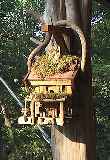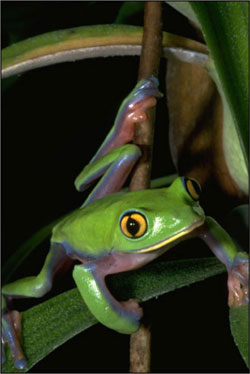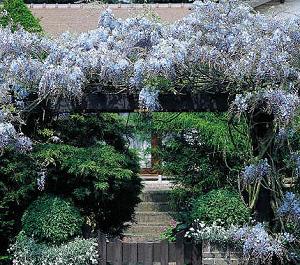|

Trees and Shrubs
Nursery plants are available as bare root, balled-and-burlapped or container-grown. Bare root plants are available only in spring.
Keep newly purchased plants moist and in the shade until planting.
Soil preparation with organic matter is important, especially if soil is a heavy clay.
Dig holes 2 to 4 inches shallower than the root ball, but much wider.
Mulching with wood chips after planting reduces need for frequent watering.
Keep pruning of newly planted trees and shrubs to a minimum.
Consider trees and shrubs a permanent part of a home landscape. If properly selected and planted correctly in an appropriate location, they will improve the appearance and increase a home's value as well as provide shade, protection from weather, privacy and year-round enjoyment.
Since trees and shrubs represent an important part of a home investment, it is essential that care be taken in their planting. Inadequate soil preparation and improper planting procedures are frequent causes of failure of a plant to thrive after transplanting.
When To Plant
The ideal planting time is early spring as soon as the ground can be worked. Avoid disturbing any plant that recently has broken bud and is producing new, soft growth.
Plant balled-and-burlapped stock before bud break and/or after growth has hardened (after mid-June), but not during the soft growth stage. Most container stock can be planted all season, but is most risky when new growth is soft. Fall planting is more risky, especially for evergreens. If it must be done, plant before mid-October and mulch with about 5 inches of wood chips or similar material to prevent early freezing of soil.
Care Before Planting
Plants purchased from a nursery may be bare-root, balled-and-burlapped, or container-grown. Bare-root plants are available only in smaller sizes of deciduous trees and shrubs. In Colorado, such plants usually are sold for early spring planting. When purchased, the roots are wrapped in a moist, loose material such as shredded wood or sphagnum. Make sure that the material around the roots is kept moist, but not soggy, until planting. Keep the package away from direct sunlight or other sources of heat. Machine-dug (spade-dug) trees also are available through some nurseries, arborists and landscape contractors.
Protect balled-and-burlapped and container-grown plants during transport from the nursery. Cover tops, particularly of evergreens, protruding from car windows or trunks with paper or burlap to reduce foliage damage and water loss caused by rapid air movement during transport. Once home, place plants in a shaded location or in the garage until planting time. If planting is delayed, keep soil ball or container watered, but avoid getting soil too wet, particularly just prior to planting time.
Preparing Soil For Planting
Few plants thrive in clay, heavy or poorly drained soils. These soils are usually not suitable for most plants because they are low in oxygen required for root growth. Improving the drainage and aeration of a heavy soil often is difficult and may require extensive preparation. Ideally, soils with poor drainage should be tiled using perforated pipe or open-jointed 4-inch agriculture tile prior to final property grading. In most cases, however, this procedure is not performed by the building contractor. To install in established properties is often too expensive.
An alternate solution is to incorporate organic matter into the soil as deeply as possible and adjust planting depth. Use only well-rotted barnyard manure, coarse sphagnum peat or thoroughly decomposed compost. Avoid fine textured organic matter, such as sewage sludge or mountain peat, since these materials do not "open up" clay soils but actually decrease pore spaces.
For every 1,000 square feet of area to be planted, thoroughly work 2 or 3 yards of organic matter into the soil by hand spading followed by rototilling. A garden tractor with plow attachments may be used for large areas. This equipment is available for rent in most localities.
Bare Root Plants
Holes for bare root plants should be large enough to permit the roots to be spread out without crowding or curving around the wall of the hole (Figure 1). Prepare backfill soil by thoroughly mixing one part coarse organic matter (not "hot" manure) with two parts of existing soil. Hold the plant so that the crown (area where the roots and top meet) is at least 2 inches above surrounding soil or lawn level. This allows for settling of soil and roots so that the final depth is the same as or slightly above the surrounding grade. Add backfill and apply water slowly.
With extra soil form a small, temporary dike just beyond the rim of the hole. Fill the dike with water and allow it to settle. Do not tamp the backfill. Check moisture level weekly by digging down near the edge of the dike. Water as needed. In irrigated lawns, remove dike after 6 to 8 weeks. In non-irrigated plantings, allow dike to remain until second growing season. Plants with heavy tops may need to be staked for one or two growing seasons. Use strips of soft cloth or straps 2 to 3 inches wide to loosely tie trees to stakes. Avoid use of pieces of hose with wire through them. While this is a common method to guy trees, it usually causes girdling of trunks.

|
 |
|
|  |
 |  |  |
|

With extra soil form a small, temporary dike just beyond the rim of the hole. Fill the dike with water and allow it to settle. Do not tamp the backfill. Check moisture level weekly by digging down near the edge of the dike. Water as needed. In irrigated lawns, remove dike after 6 to 8 weeks. In non-irrigated plantings, allow dike to remain until second growing season. Plants with heavy tops may need to be staked for one or two growing seasons. Use strips of soft cloth or straps 2 to 3 inches wide to loosely tie trees to stakes. Avoid use of pieces of hose with wire through them. While this is a common method to guy trees, it usually causes girdling of trunks.
Balled-and-Burlapped and Container-Grown Stock
If the soil is a heavy clay, make the planting hole 2 to 4 inches shallower than the soil ball. If the soil is sandy, the hole should be no deeper than the root ball. Dig the hole much wider, however. Place the plant in the center of the hole on undisturbed soil. Remove containers made of metal, tar paper or plastic (bottom of can does not need to be removed). Slit or tear containers made of papier-mache, peat or wood slats (baskets). Always remove wire or plastic netting if these materials are used to hold the soil ball. Remove the top two-thirds of wire baskets after placing in hole.
If the plant is wrapped in burlap, leave the burlap in place except for the top portion. Make sure that twine around the trunk and across the top of the ball is cut and removed.
Put backfill into the hole and water slowly. With the extra soil, form a temporary water basin or dam just beyond the edge of the backfill. In about one week, fill the reservoir with water. Reapply water only when the soil begins to feel dry at 4 to 6 inches deep. Avoid frequent, light waterings. Because of differing water requirements and potential damage to tree trunks during mowing, it generally is best to keep lawn areas well away from trees.
Pot-Bound Container Stock
Shrubs and trees often are grown in containers long enough that roots become pot-bound resulting in the development of roots that encircle the root ball, which over the years may girdle the trunk or stems.
When containers are removed prior to planting, check the root ball. If a mass of encircling roots is present, cut up and down the ball 1/2-inch deep in four or five places with a sharp knife then plant immediately. If the majority of the roots are at the bottom of the ball, split the root ball all the way through from the bottom about half way to the top. Spread the two halves over a mound of soil in the planting hole. Backfill and water immediately (see Figures 4a and 4b).
CAUTION: Do not use this method on newly potted plants, balled-and-burlapped plants or container plants where roots are not pot-bound at the base.
Mulching
Apply a loose mulch such as wood chips over the planted area to a depth of 5 inches. This eliminates the need for cultivating and reduces frequency of watering.
The best mulches for trees and shrubs are wood chips, bark chunks or similar materials. To reduce weed growth, a landscape fabric can be put down before chips are applied. Do not use solid polyethylene sheet plastics. Plastic films exclude air exchange to roots. This can kill your plants.
Fertilizing
Newly planted trees and shrubs should not be fertilized until after one growing season. Never put fertilizers such as dry pellets or fertilizer "spikes" containing nitrogen in the backfill since root injury may result.
Protection of Young Trees
Young trees, particularly thin-barked types such as soft maple, honeylocust and crabapples, may be sun-scalded during the first year or two after transplanting. This injury, usually on the southwest sides of trees, is caused by sudden temperature changes and water loss in late winter. Wrapping the trunk and large branches prior to winter will reduce this problem. Remove wrap in spring to prevent harboring of insects and diseases beneath wrap.
Use commercial crepe-type tree wrap. Start at the bottom, overlapping wrap as it is applied upward to the second branch. Secure the top end with a staple or small tack. Do not use twine or tape to hold wrap in place because this may result in girdling of the tree.
Pruning
Newly planted trees and shrubs should be given only minimal pruning. Removal of too much top affects the production of food energy (carbohydrates) and can result in poor root development. After planting, prune out broken branches and those with weak or narrow crotches. With trees, leave some of the lower limbs and sprouts from the trunk even though they will be removed later. The reason for this is that these limbs provide the closest source of food energy for root development.
 Wisteria Vine; gorgeous |
 |
|
|
|
 |  |  |
 
|




